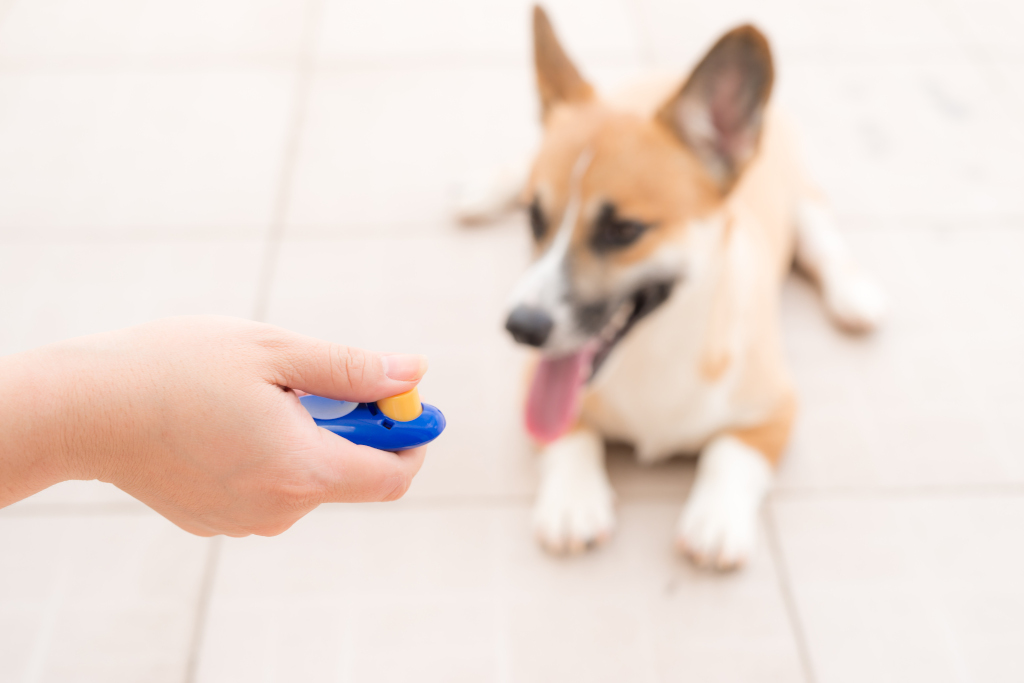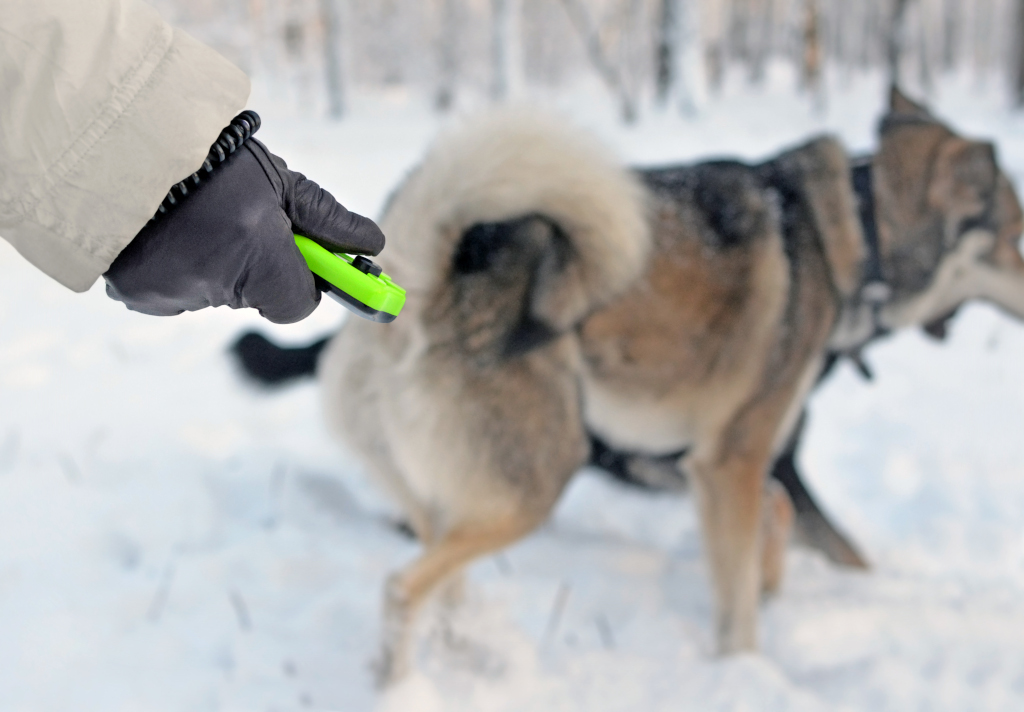
There are many ways to train dogs. Some people prefer the alpha dog or dominance training method, while others prefer the modern reward-based approach. And one that has become increasingly popular is clicker training.
So what exactly is clicker training?
Is it the best method of training your furry friend?
Keep reading to learn everything you need to know about clicker training for dogs, including how to get started, the benefits and disadvantages, and some helpful tips.
What is Clicker Training & How Does it Work?
Clicker training is a form of operant conditioning that uses positive reinforcement to train dogs. The basic idea is that you mark the desired behavior with a clicker, which tells the dog what they’ve just done is correct. This reinforces the behavior, and the dog is more likely to repeat it when the same thing is asked of them.
Clicker training always begins with the dog associating the click sound with a treat, known as charging the clicker. This is the initial training phase, which teaches the dog what the click means and is done by clicking the clicker, then immediately offering the dog a treat. Remember, it is click then treat, NOT click and treat at the same time. Once your pup understands that a click means a treat is coming, you can then begin working on teaching your dog specific behaviors.
Say you want to train your pooch to sit on command, for instance, and assume that you’ve already charged the clicker. After giving your dog the hand signal and the moment their butt hits the ground, you want to press the clicker and give them a treat. It is important to click at the precise moment the desired behavior takes place, and I’ll explain later why this is crucial.
Once your canine becomes more proficient at the hand signal, you can add the verbal cue, “sit,” just before you do the hand signal. Over time, your dog will learn what “sit” means and will be able to respond to the command without the hand cue.
This is just one simple example. There are many other things you can train your dog using a clicker, from basics like sit, stay, down, and off to more complex tricks like shaking hands, playing dead, and rolling over, to name a few.
You May Also Like: Best Dog Training Books

Can't I Just Use Words Like "Yes" or "Good Boy/ Girl"? Do I Really Need a Clicker?
You can, of course, use marker words like “yes” or “good boy/ girl” to train your dog. The problem with that, though, is it may be less effective, especially if your whole family is involved in the training.
Why?
Well. That’s because everyone has a slightly different tone of voice and body language when saying the same words. This means your “good boy” may not mean the same thing to your pup as your partner’s “good boy,” which can confuse your pooch and make it difficult for them to understand what is expected.
On the other hand, the clicker is consistent and always communicates the same message in the same way, no matter who is using it. Every time you press it, your fido knows precisely that they did something correctly and are about to get a treat for it. It eliminates any possibility of inconsistency and, therefore, helps speed up their learning process.
Advantages of Dog Clicker Training
There are many advantages to clicker training compared to other methods:
- It is fast and efficient. Clicker training is highly effective in shaping the desired behaviors in your dog and, without a doubt, one of the fastest ways to teach your pup new tricks because it allows you to mark the exact moment your dog did something correctly.
- It helps you communicate clearly. As mentioned earlier, clicker provides a clear and concise way to communicate with dogs, eliminating any guesswork on the dog’s part and making it easier for them to understand what you want.
- It focuses on positive reinforcement. Clicker training focuses on reinforcing desirable behaviors instead of punishing undesirable ones. It does not involve physical punishment or verbal reprimands, meaning it is stress-free and will not damage the relationship between you and your dog.
- It’s fun for your pooch. Clicker training is not only effective but also fun and rewarding for dogs. This also helps build and reinforce a sense of trust and understanding and strengthens the bond between you two, which this strong bond will make it easier for you to teach more complex behavior and tricks in the future.
- It’s easy to learn and use. Clicker training is straightforward, and anyone can pick up the basics in a short amount of time. This makes it perfect for first-time pet owners or those with limited training experience.
Disadvantages of Dog Clicker Training
Nothing is perfect, and clicker training is no exception. Here are some of the drawbacks:
- Poor timing may inadvertently reinforce the behavior you don’t want. The success of clicker training depends heavily on timing and that you have to reward your dog within a fraction of a second after they have done something correctly. Otherwise, your dog may be confused at best and, at worst, may inadvertently learn the wrong thing. Say, for instance, you are training your dog to greet visitors politely by sitting. They initially offer a nice sit when your guest arrives, but just before you click the clicker (as you fumble for it), they suddenly decide to jump up, and right at that moment, you click it. That one click has just communicated to your pup that jumping up is what you want, which is the opposite of what you are trying to accomplish.
- It may not be suitable for all dogs. Clicker training is a reward-based training method. And unfortunately, not all dogs are motivated by treats or toys. So if your pup is not reward-driven, clicker training may not be as effective. Also, some dogs may find the clicking noise intimidating. Therefore, it is essential to introduce the clicker cautiously.
- It can get expensive. Clicker training requires a lot of treats and can add up quickly, especially if you have a large dog. So if you’re on a budget, clicker training may not be your best option either.
Tips for Successful Clicker Training
- Make sure your timing is perfect. The key to successful clicker training lies in the precise timing of when you click and reward your pup. So pay attention to that, and as soon as your canine has done what you want them to do, click and reward them immediately.
- Use treats with sound judgment. Although treats are a great reward during training, using them excessively can cause your pup to become overfed. The best way to avoid this is by breaking treats into tiny pieces and only rewarding your pup with one piece at a time unless they have done something extraordinary and you want to jackpot them.
- Don’t overdo it. Training your fido for too long may cause them to become bored. So keep the sessions short, around 10-15 minutes, and always end the session on a positive note.
- Use a variety of rewards. You don’t have to rely on treats alone to reward your pup. In fact, using a variety of rewards such as praise, petting, toys, or playtime with you can help keep your pup motivated and engaged during the training session. So mix it up to keep things interesting.
- Be consistent. Always use the same word or hand signal for a particular behavior, and ensure everyone in the family is on board. This will prevent confusing your pup and help them learn whatever you try to teach them more quickly.
- Be patient. As with any training, your pooch may make mistakes and take a while to learn something new. So be sure to stay patient and positive with them, even when it seems like they are not getting it right away. With patience and consistency, you’ll eventually get there!
Final Thoughts
Whether you’re teaching your pup basic obedience commands, house manners, or fun tricks, this reward-based method can help make the training session more enjoyable for you both.
Just make sure to click at the precise moment your pup does what you ask them to correctly, consider mixing up the rewards, keep the training session short, and be consistent with what you’re teaching. And with a little patience and practice, you should see good results in no time!
Good luck!

